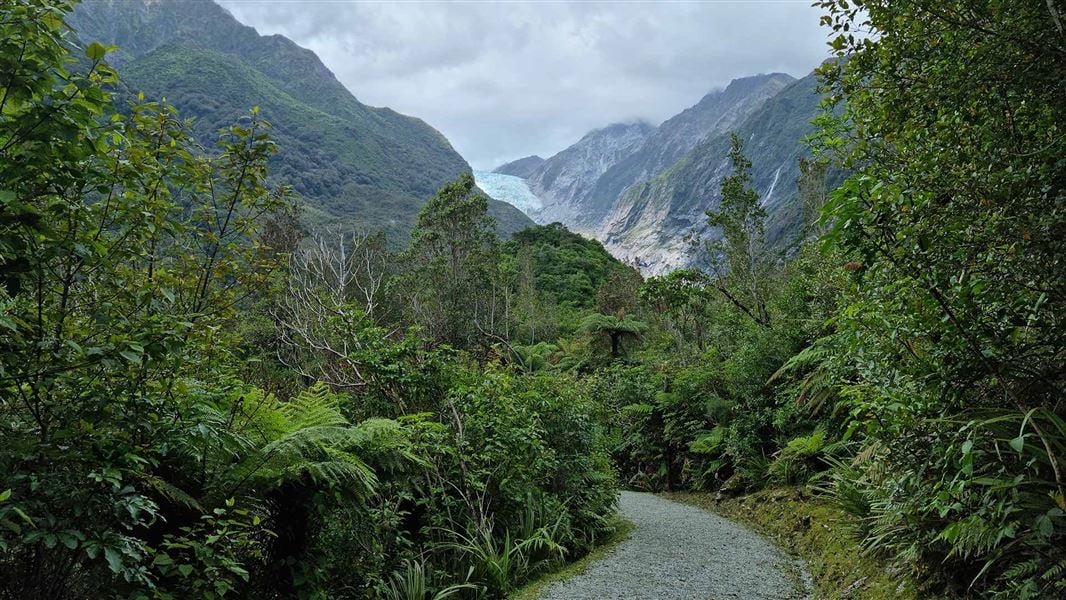From Franz Josef township drive south over the Waiho River bridge. Turn left after the bridge on to the Franz Josef Glacier Access Road. This road has an unsealed surface but is suitable for cars, campervans and buses. Please take care, keep left, and keep your speed down. Most of the walking tracks are accessed from the car-park at the end of this 4km road.
Look after yourself
The Waiho Valley is a dynamic and potentially hazardous environment, and river levels and water channels can change rapidly, particularly during and after heavy rain. The entire river bed can become completely covered with flood water. Do not attempt to cross enlarged or rising streams. When conditions are considered unsafe a sign will be placed across the track indicating the limit of safe access.
Dress sensibly, wear sturdy footwear and take suitable precautions in case of a sudden weather change. A cold down-draft off the glacier is normal in the valley, and rainstorms occasionally catch visitors by surprise.
Ice collapse and rock fall can occur at any time at the terminal face of the glacier, and for this reason do not proceed beyond the rope barrier. Barriers and warning signs are there for your safety. Please read and respect them. Even if you think you know what you are doing, you may lead other curious visitors into dangerous areas.
General care
Don’t litter. No rubbish bins are provided in the valley, so be prepared to take out what you bring in.
There are good flush toilets provided at the glacier car-park for your convenience, but there are none further up the valley; so think before you leave on your walk.
Do not feed the wildlife, particularly kea. This changes their natural behaviour, can be detrimental to their health, and leads directly to the destructive behaviour kea are unfairly blamed for.
Don’t modify or remove any safety signs or barriers in the valley. These are there for safety: yours and the people coming after you.
All drone use must be authorised by DOC
You must have a permit to fly a drone on public conservation land.
Visit our Drone use on conservation land page for more information.
In the last ice age the glacier extended in a huge ice-sheet to beyond the present coastline. Although today’s glacier has retreated considerably, echoes of its frozen past are still apparent in the present landscape.
The terminal face of the glacier is less than 300 metres above sea level and is just one of three to be this close to the coastline.
Sentinel Rock
Sentinel Rock offers impressive views of the glacier, the glacier valley, the Waiho River and dramatic examples of colonising plants. To view the massive snowfields of the upper neve you need to take a flight in a helicopter or ski plane.
Sentinel Rock and the other rock outcrops nearby are hard schist bedrock which have withstood the massive scraping by the ice as the glacier passed by and over. The French term “roche moutonnee”, meaning ‘rock - sheep’ is used to describe these distinctive rounded rocks which were shaped by glaciers.
In 1865, Sentinel Rock had just emerged from beneath the retreating Franz Josef Glacier/Kā Roimata o Hine Hukatere ice when the valley was first visited by Sir Julius Von Haast. Until 1909 ice pressed against Harper Rock just in front of Sentinel Rock.
Where the glacier has dumped a veneer of rubble over the bedrock, plant succession is rapid from low shrubs of tree daisy (olearia) and tutu to young rata and kamahi forest which emerge after 100 years. Where bedrock is bare, succession is much slower. Lichens and mosses cover the rocks and shrubs begin growing in crevices.
Lord of the Rings
Mount Gunn in the Franz Josef Glacier area was a location for Ered Nimrais.
Westland Tai Poutini National Park Visitor Centre
| Phone: | +64 3 752 0360 |
| Email: | westlandnpvc@doc.govt.nz |
| Address: | 69 Cron Street Franz Josef Glacier 7856 |
| Hours: | Visitor centre hours and services |
